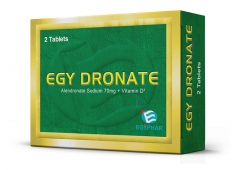CERVITAM
CORVAST 80
DAFREX
EGY DRONATE
EGYNIR
EGYURSO
FERROCAL
FINOFIB
GRAMOCEF
KOKAST 10 MG
LORAFAST
PEDICAL PLUS
RAMSOOM
VEDGE SUSPENSION
SELECTIVAL
OSTOVAL
TERVENTIN
TOTAVIT SUSPENSION
AMEBAZOLE
ARCA-ZINC
ARTHINEUR
COMBIFLOXIN
HELICURE
LODIPINE
UNOCRON 60
ZISROCIN
METHOCARBEX
ZISROCIN SUSPENSION
EGYNIR SUSPENSION
MODAZAR 100+25 MG
TOTAVIT TABLET
VEDGE TABLET
CORVAST 20
CORVAST 40
TORVAST 10
TORVAST 20
TORVAST 40
KOKAST 4 MG
UNOCRON 30
LEVOCITRONE
SHATOO
CITALOFAR
VARDARICT
ACPOPHAR
VANISH
IMMUNIPHAR
EGY DRONATE


Composition
Pharmacological action
Pharmacokinetics
Drug Interactions
Indication and usage
Dosage and administration
Contraindications
Side Effects
Warning and precautions
Instructions to Patients
Pregnancy and lactation
Overdosage
Package
Store
Each tablet contains:
Alendronate sodium trihydrate 91.38 mg (Eq. to 70 mg alendronic acid)
Vitamin D3 powder 2800 IU



